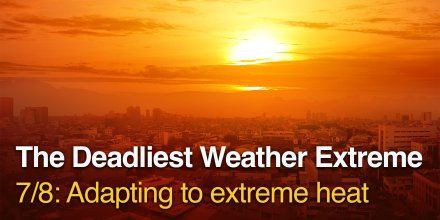
Webinar: Climate Data Tools for Resilient Urban Planning
This second webinar in the series presents digital tools that turn climate data into actionable strategies for urban resilience.


This second webinar in the series presents digital tools that turn climate data into actionable strategies for urban resilience.

Rising heat risks demand better planning, stronger warning systems, and targeted adaptation strategies.
|
|
|||||||||
|---|---|---|---|---|---|---|---|---|---|
|
Icon
|

|

|

|

|

|

|

|

|
|
|
Temperature (°F)
|
|||||||||
|
Temperature felt (°F)
|
48° |
46° |
50° |
55° |
58° |
56° |
51° |
46° |
|
|
Wind direction
|
W |
WSW |
WSW |
W |
W |
WSW |
W |
WSW |
|
|
Wind speed (mph)
|
W
10-21
10-21
|
WSW
11-23
11-23
|
WSW
13-26
13-26
|
W
12-27
12-27
|
W
9-24
9-24
|
WSW
7-18
7-18
|
W
5-10
5-10
|
WSW
6-11
6-11
|
|
|
Precipitation (in/3h)
|
-
0%
-
|
-
0%
-
|
-
0%
-
|
-
10%
-
|
< 0.04 in
25%
< 0.04
|
< 0.04 in
40%
< 0.04
|
-
0%
-
|
-
0%
-
|
|
|
Precipitation probability
|
0%
|
0%
|
0%
|
10%
|
25%
|
40%
|
0%
|
0%
|
|
|
Precipitation hourly
|
|||||||||
|
rainSPOT
Precipitation distribution within 20 km
|
|
Overnight into Friday the sky remains overcast, but most clouds give way in the morning. In the afternoon the weather is changing with a mix of clear and cloudy skies and a chance of showers. The sun will not be visible. There is only a low chance of Precipitation (around 30%). Temperature highs are likely to reach 64 °F. At night and for the afternoon a gentle breeze is expected (8 to 12 mph). Friday morning expect a moderate breeze (12 to 18 mph). Gusts to 27 mph are possible. Winds blowing from West. The weather forecast for Rakhtyn’ya for Friday can be accurate in parts but deviations are expected. Check again for latest updates.
Pressure: 997 hPa
Timezone: GMT+05 (UTC +05:00h)
The location marker is placed on Rakhtyn’ya. Orange crosses indicate lightning. Data provided by nowcast.de (available in USA, Europe, Australia). Drizzle or light snow fall might be invisible for the radar. Precipitation intensity is colour coded, ranging from turquoise to red.
The real-time satellite image combines visible light during daytime with infrared radiation during nighttime. At night, the image is not dark as infrared radiation can detect temperature differences. Unfortunately, low clouds and fog are difficult to distinguish from ground temperatures and thus can be almost invisible during the night. Meteosat satellite images for Europe are updated in real-time every 5 minutes. GOES-16/GOES-17 (North & South America) and Himawari (Asia) images update every 10 minutes.
Precipitation is estimated from radar and satellites. Precipitation estimates from satellites are less accurate at night than during daytime.
© 2025 meteoblue, NOAA Satellites GOES-16 and EUMETSAT. Lightning data provided by nowcast.

This second webinar in the series presents digital tools that turn climate data into actionable strategies for urban resilience.

Rising heat risks demand better planning, stronger warning systems, and targeted adaptation strategies.
 Verkhniy Khurumpaul'
Verkhniy Khurumpaul' 
 Verkhnevol’inskiye Uvaly
Verkhnevol’inskiye Uvaly 
 Verkhnenil'dina
Verkhnenil'dina 
 Timko-Suy
Timko-Suy 
 Sos'va
Sos'va 
 Shomy
Shomy 
 Sartyn'ya
Sartyn'ya 
 Sarady-Paul’
Sarady-Paul’ 
 Sangitur
Sangitur 
 Posoldino
Posoldino 
 Patyspaul’
Patyspaul’ 
 Patrasuy
Patrasuy 
Advertising is essential to maintain our free website with unique detail and accuracy.
Please whitelist www.meteoblue.com on your ad blocker or consider buying one of our products:
Already have a subscription?
Then please login.